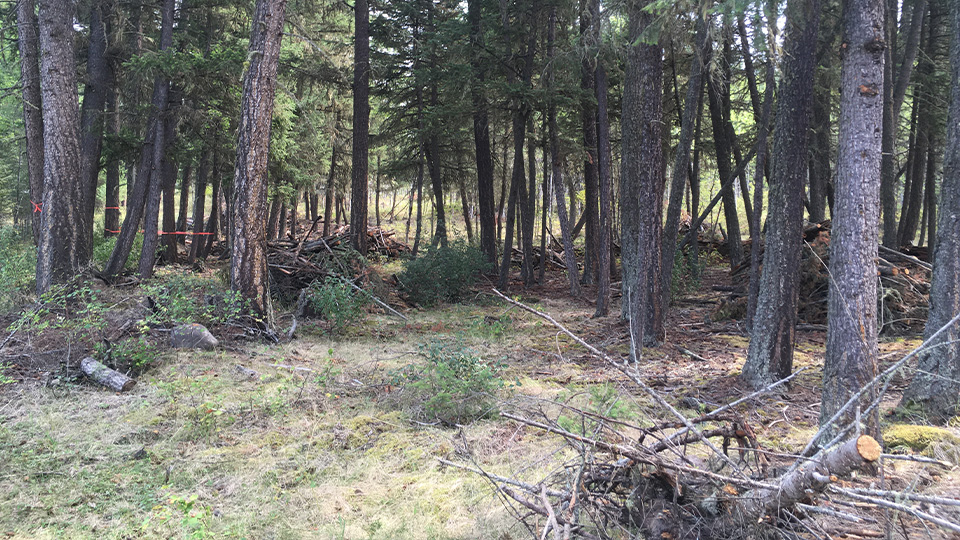Wildfire Risk Reduction Near Williams Lake
In 2022, Farmland Advantage (FLA) expanded to begin a wildfire risk reduction pilot project funded by the Government of British Columbia through the Ministry of Forests. This pilot is focused on reducing wildfire risk and increasing community resiliency to wildfires across British Columbia.
Five sites totaling 380 hectares were identified and selected for the pilot project. Each site was selected for its potential to mitigate the risk of wildfire in the immediate and adjacent areas. Three of the five sites are in the Cariboo region, which has experienced many significant wildfire seasons in the past decade. These intense wildfire seasons have demonstrated the importance of addressing wildfire risk on public and private lands. Farmland Advantage is proud to partner with farmers and ranchers in the region to conduct important wildfire-risk reduction work on private land.
J & S Fletcher Inc.:
Jared and Shelley Fletcher live near William’s Lake, where they ranch cattle. The couple was approached in 2020 when their area was highlighted as one of interest through FLA’s targeting methodology; they agreed to participate, and a grassland-focused site assessment was completed later that year. Grassland projects help farmers and ranchers continue their efforts to maintain the health of native grasslands. Work on the Fletcher property focused on habitat enhancement for the benefit of species at-risk and was completed on the site throughout 2021 and 2022. Actions taken included targeting grazing in specific fenced-in locations to reduce fine fuels and control noxious weed species within the grazing area. This work was funded by the Government of Canada through the federal Department of Environment and Climate Change.
In 2022, the Fletchers accepted an invitation to participate in the Wildfire Risk Reduction Pilot Project. In the fall of 2022, an FLA Advisor and a Registered Professional Forester visited the property to develop a site management plan aimed at mitigating wildfire risks. A critical objective of the work on the Fletcher property is to continue the landscape level fuel break already conducted on Crown Land through to private land. Fuel breaks alter the forest in a way that interrupts the fuel continuity and can prevent, mitigate, or slow a fire. Existing programs like the Crown Land Wildfire Risk Reduction (CLWRR) program mitigate risk on public land, but private landowners often lack opportunities to do this scale of risk reduction. Forestry work in particular can be extremely cost-prohibitive.
This program can support ranchers and farmers in the province who are overwhelmed by much-needed wildfire risk reduction on their properties and do not have the time and resources to tackle this on their own.
Throughout 2023, work was completed by forestry professionals to thin and prune the tree stand, removing brush, shrubs, and small trees with a diameter of fewer than seven centimetres. The material removed will be piled and burned to prevent it from being consumed as wildfire fuel later. The process of piling and burning is different depending on the nature of the debris, the ecosystem, the climate, and other factors. In general, thin diameter materials are made into small piles located a safe distance away from standing trees and fence lines and left to cure, so they burn quickly and effectively when the time comes. Piles are only burned when appropriate soil moisture and weather conditions permit. When burning there must be an appropriate “venting index“, which is a daily forecast that estimates how well the atmosphere will disperse smoke. If the treatment is close to urbanized or residential areas, these regulations are stricter. The registered forester develops a detailed prescription which includes the exact process for the characteristics of the piles and the burning process in each site prescription.
Targeted grazing practices will be used to maintain the work going forward, positioning this land as part of a wildfire resilient interface zone between the ranch, surrounding properties, and the nearby community.
Wildfire Risk-Reduction in the Cariboo
Farmland Advantage is just one program working to ensure a resilient agricultural community in the Cariboo. Collaborative efforts are being made to reduce wildfire risk in the region and to protect and prepare communities. Several large-scale projects have been completed or are ongoing through the BC Wildfire Service, including one near Williams Lake and another near Green Lake. Another organization working to reduce wildfire risk in the region is the Forest Enhancement Society of BC (FESBC), with support from the Governments of BC and Canada. FESBC projects have reduced wildfire risk in 120 communities.
Through the Wildfire Risk Reduction Pilot, FLA and its funders hope to continue to reduce wildfire risk and increase community wildfire resiliency across British Columbia.
Farmland Advantage is an IAF Program. For the 2023-2024 Fiscal year, Farmland Advantage gratefully acknowledges the financial support of the Investment Agriculture Foundation of BC, the Government of Canada through the federal Department of Environment and Climate Change and the Province of British Columbia through the Ministry of Environment and Climate Change Strategy, the Ministry of Water, Land and Resource Stewardship, and the Ministry of Forests.








